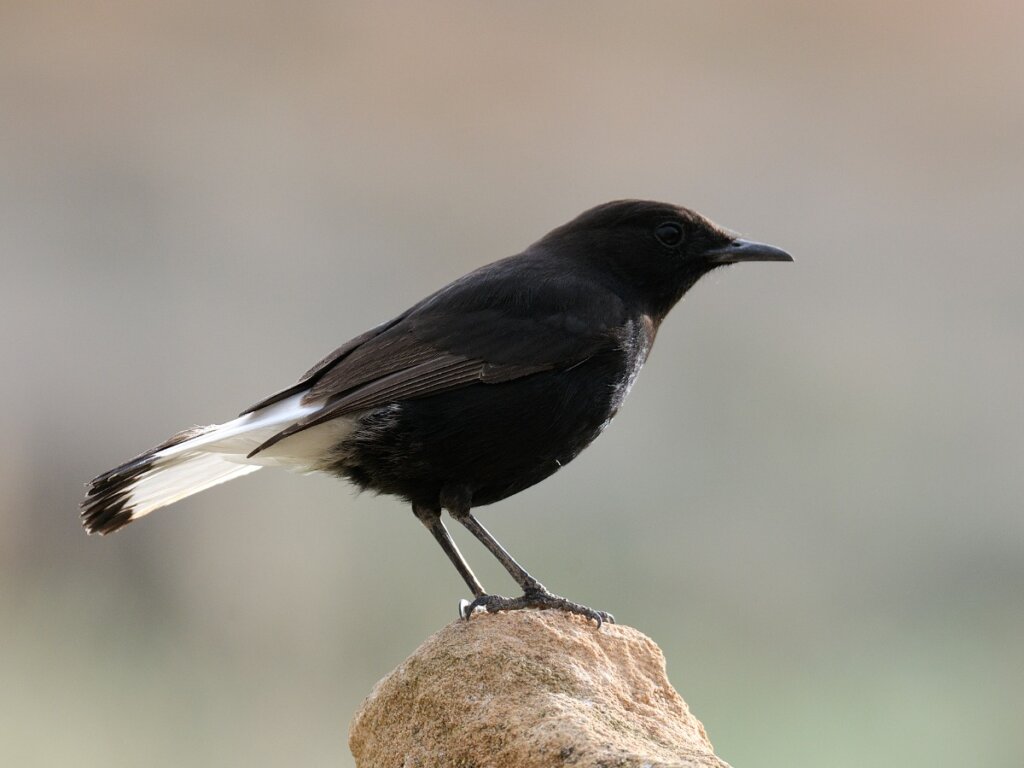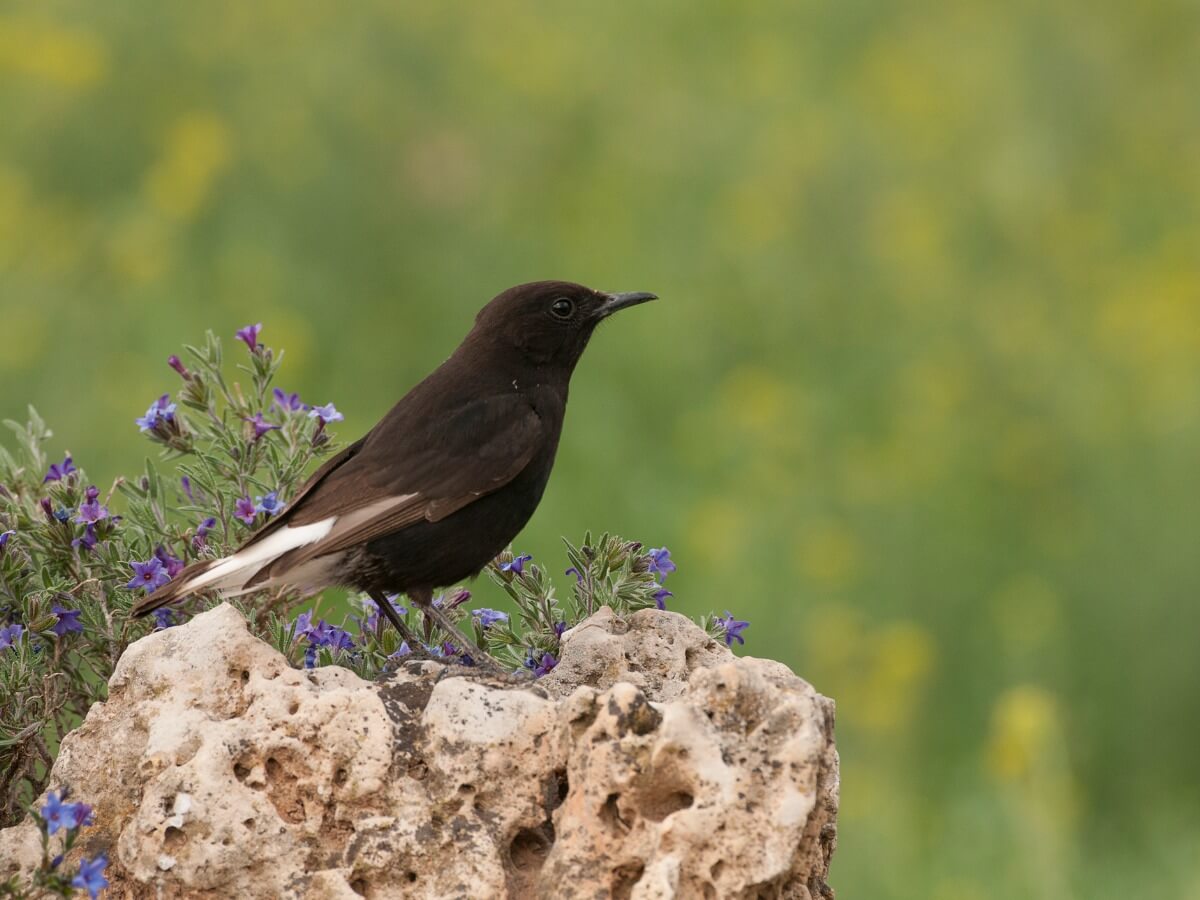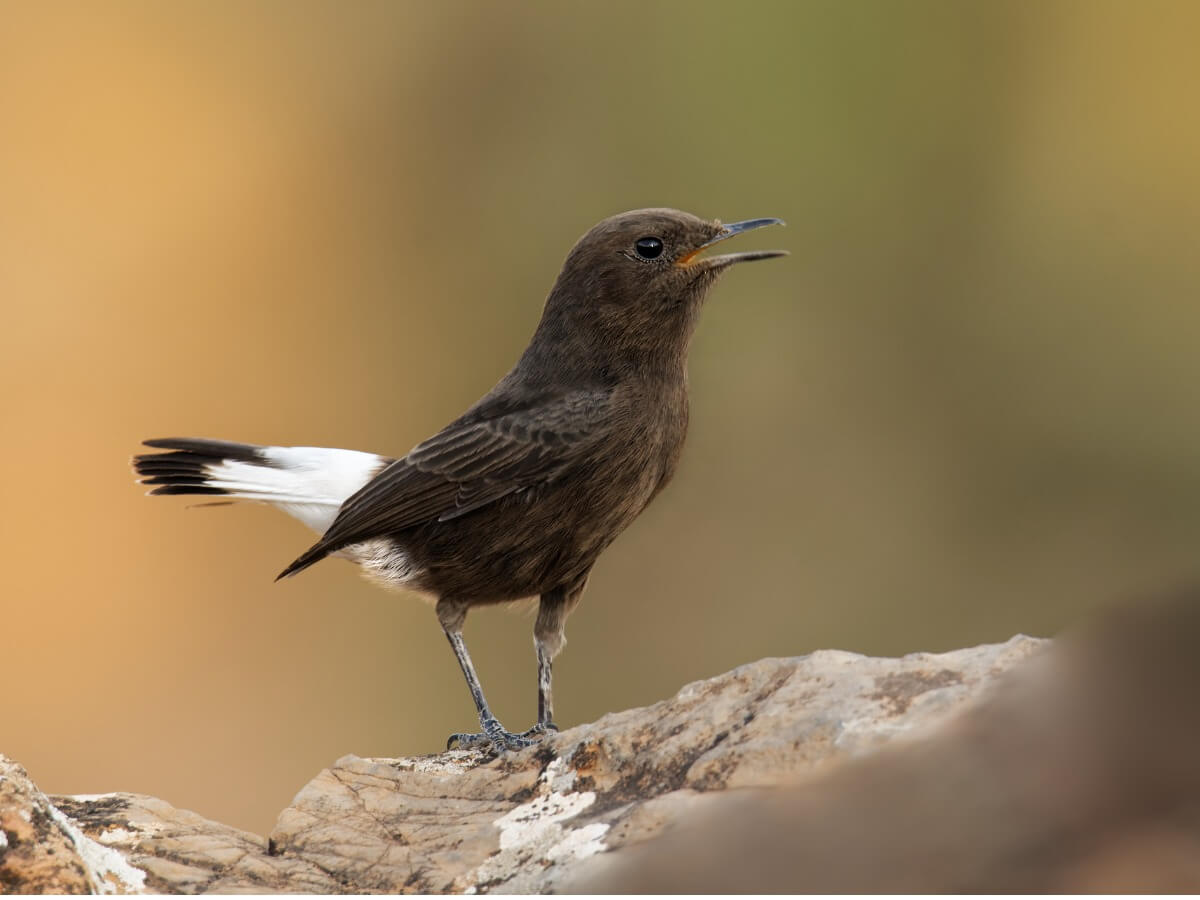Black Wheatear: Habitat and Characteristics

The black wheatear is a medium-sized bird that exhibits one of the most curious courtship behaviors in the animal world. This is a species in which we can be observed how natural selection acts to maintain the best adaptive characteristics.
This bird belongs to the order of the passerines and makes use of songs to win over its mates. In addition, the genus it belongs to includes a great diversity of wheatears, but this time we’re going to speak specifically about Oenanthe Leucura. Read on and learn everything that makes this species unique.
Habitat of the black wheatear
This bird prefers habitats with little vegetation, such as cliffs, boulevards, slopes, and ravines. They may even live in abandoned buildings, quarries, or dams, as long as there are tall structures to make their nests.
Its distribution is restricted to the Iberian Peninsula and North Africa. In Spain, it remains in the mountainous systems of the Mediterranean, although it has a preference for dry places with little rain. In winter it travels to areas near the tropics, such as western Andalusia.

Physical characteristics
The wheatear is around 18 centimeters (7 inches) long, with a dark brown coloration throughout the body, while the tail stands out for its whiteness. In addition, at the end of the tail feathers, it has a kind of inverted black “T”, which allows for easy identification. As for its beak and legs, they’re also black.
The females are of lighter tones, with browner colors and spots on the neck and belly, but following the same patterns as the male. The young have brown tones in the belly area, with black plumage along their bodies.
Black wheatear behavior
This bird spends the night in pairs inside caves or cavities during the spring, while in winter it sleeps in groups. Furthermore, this bird is considered to be more sociable with other specimens of its species than with other types of wheatears. For this reason, specimens can be seen feeding together with up to 6 individuals.
In general, it’s a shy and skittish animal that shows defensive behavior when it feels in danger. It does so by means of its tail, constantly wagging and lifting it, and trying to look more robust to deter its aggressor.
Interaction with other species
They seem to have territorial behavior, as males of other species respond negatively to this bird’s songs. According to research published in the scientific journal Ethology, it was determined that 5 species of passerines reacted to the song of the black wheatear, indicating possible territoriality. In addition, aggressive specimens have also been seen during the breeding season.
This can also mean safety, as it would indicate to other species that there’s no danger of being found by predators.
Black wheatear diet
Their diet is made up of insects captured on the ground through hunting, in which they use a light hopping movement. Black wheatears usually search rocks, crevices, bushes, and cavities, trying to find some orthoptera, mantis, hemiptera, lepidoptera, flies, hymenoptera, etc.
Reproduction of the black wheatear
This bird is monogamous, although some cases of polygyny have been observed – 1 male and 2 females. Pair bonds are maintained throughout the year, as they even return to nest in the same caves or crevices.
To get a mate, the male performs a chase ritual, in which he tries to convince the female. This process takes place at the end of December, so that between January and February the couples are already established.
Chase and dance
During courtship, the male must demonstrate to the female that he’s her best choice. To do this, it makes extravagant flights, in which it shows its plumage and shows off its size. Accompanied by his song, he slowly ascends to attract the attention of the potential partner.
In addition, when he touches the ground he continues with a dance, which consists of small jumps opening its plumage and showing its tail.
The objective of the dance is to attract the attention of the female, but it also seeks to show the possible nesting places. In fact, before the pair is established, the male shows several caves waiting for his partner to accept one and enter it.
At this moment, their strangest behavior occurs: the transporting of stones.
Stone transporting
The wheatear nest is usually built on top of a pile of stones. For this reason, the future father transports a large number of them to the nest. However, not all these stones become an essential part of the nest. However, they may not even be used for this. This means that the males carry almost 3 kilograms of stones that may not be used.
Although it may seem strange, the reason why they have this behavior is because of an additional type of evaluation that the female makes. Despite conquering her, the male still has to prove his worth by transporting stones. This helps the expectant mother know how much effort to put into her reproduction and also shows her the genetic quality of the male.
You may think that it doesn’t make sense, as a bird can’t be aware of whether or not its mate has good genetic quality with the naked eye. However, what the female sees is the number of stones that her suitor manages to bring. That is more than enough for her, because if he manages to bring many of them, then that means his wings are well developed and strong.
Copulation
If the future mother decides that the male is a good choice, copulation takes place, in which both perform a dance that ends with the male fertilizing the female. At this point, the amount of stones that are carried is very important, since if the mate fails to meet expectations, the bond may dissolve.
Dissolution of the couple is rare, but it can take place.
Laying and incubation
The mother begins laying eggs no later than mid-February and lays a highly variable amount. Females can lay an average of 3 to 4 eggs per clutch, being able to have up to 10 clutches. Each of the new hatchlings hatches after 14 days of incubation and all will be cared for by the mother and fed by the father.
At 14 or 15 days the chicks usually leave the nest, although they start their first test flights on the third day. Finally, a week later, they can feed themselves, but they will continue to be cared for by their parents for 15 more days before becoming independent.
State of conservation
On the Red List of the International Union for Conservation of Nature, black wheatear is a species of least concern. However, a reduction in its population has been detected, although this hasn’t been constant. It has been proposed that the invasions of grasslands and the reforestation of arid zones may be some factors associated with this situation.

Birds typically display some of the most beautiful courtship patterns, and this wheatear is no exception. In the end, it must be remembered that these behaviors serve the animals to select the best-prepared mate as far as the production of offspring is concerned. In other words, natural selection always works from the shadows.
All cited sources were thoroughly reviewed by our team to ensure their quality, reliability, currency, and validity. The bibliography of this article was considered reliable and of academic or scientific accuracy.
- Møller, A. P. (1992). Interspecific response to playback of bird song. Ethology, 90(4), 315-320.
- Moreno, J., Soler, M., Møller, A. P., & Linden, M. (1994). The function of stone carrying in the black wheatear, Oenanthe leucura. Animal Behaviour, 47(6), 1297-1309.
- Joan, R. E. A. L. (2000). Los incendios pueden favorecer la recolonización de la collalba negra Oenanthe leucura. Ardeola, 47(1), 93-96.
- Richardson, F. (1965). Breeding and feeding habits of the black wheatear Oenanthe leucura in Southern Spain. Ibis, 107(1), 1-16.
- Soler, M., Moreno, J., Møller, A. P., Lindén, M., & Soler, J. J. (1995). Determinants of reproductive success in a Mediterranean multi-brooded passerine: the Black Wheatear Oenanthe leucura. Journal für Ornithologie, 136(1), 17-27.
- Moreno Klemming, J., Carrascal, L. M., Salvador Vilariño, V., & Salvador Milla, A. (2016). Collalba negra–Oenanthe leucura (Gmelin, 1789).
